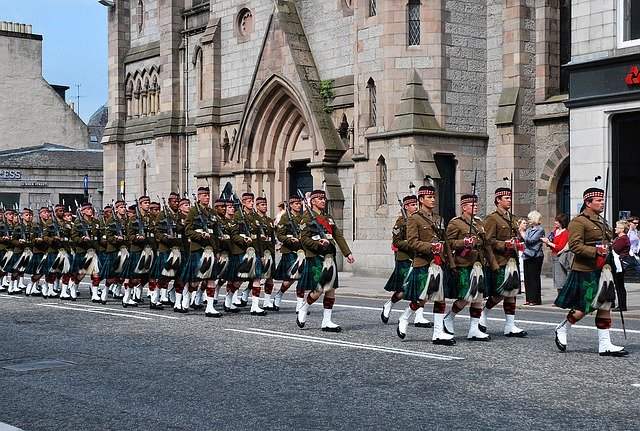The Evolution of The Modern Great Kilt
What comes to your mind when you hear the word Scotland? Well, two things will surely cross your mind – the first one being the scenic beauty there and the second one involves Scottish people dressed in fancy kilts.
 |
| Image source: Pixabay |
Known as the national dress of Scotland, a Scottish great kilt is a well-recognized form of clothing not only in Scotland but in the entire world. However, the great kilt is more than just a dress for Scotts and Highlanders – it’s a symbol of pride in their rich culture that dates back to the 16th century. In this article, we will briefly walk you through the history of the great kilt that is deeply rooted in the Scottish culture to where it stands now.
The Origin of The Traditional Kilt
The great kilt, also known as a belted plaid, hails from the woolen cloaks or brat worn in late 1500. Before this, the Scotts largely wore yellow/ saffron tunics called Leine Croich until Henry the VIII forbade them. The Scotts then turned towards woolen cloaks as the primary form of clothing. As the production and use of wool became increasingly mainstream, the length of the cloak increased such that it could be pleated together and belted. More precisely, it used to be approximately 2 yards wide and 4 yards long and to achieve this, two loom width of wool had to be sewn together. This cloak was then pleated to be worn around the waist and secured with a belt. The remaining length was then draped over the shoulder like a cloak or brought over the head to protect against the harsh weather.
Another name for these plaids was breacan, primarily because of their chequered pattern. The check pattern simply consisted of two or three colors which were mainly extracted from natural dyes including berries and plants.
Modernizing The Traditional Kilt
The tailored version of the traditional kilt that appeared in the 18th century is much closer to the modern day kilt. This occurred rather unintentionally when an army tailor, Parkinson, from England visited the Highlands to finalize the matter of troops’ clothing after the occupation of Scotland. During his visit, he got caught up in a storm and so stayed with a local Quaker Thomas Rawlinson. Rawlinson informed Parkinson that most soldiers had to work naked since the plaids were too bulky and to overcome this issue, Parkinson designed a shorter version of the plaid. With the original plaid cut I not two, the pleats were sewed in the bottom part while the upper part was left to be draped over the shoulders. This new version of the great plaid was then adopted as the uniform of Highlander’s army and it became popular even outside of Scotland. With the evolution of chemical dyes and coloring, weavers were able to produce more intricate and colorful patterns.
A Short Period of The Downfall of The Kilt
The Jacobite Rebellion in 1745 was another turning point in the history of the great plaid. The Jacobite Rebellion was an attempt to Restore a Stuart king on the British throne but it was not successful. As a punishment for this revolt, a law was passed which barred the wearing of Highland clothes for everyone except for the soldiers in uniform. For the next 40 years or so, the only source of the promotion of the kilt were the Scottish soldiers deployed in other countries.
The Ultimate Revival of The Great Kilt
A great turn of events occurred in 1822 when King George the IV visited Scotland. Being the first monarch to visit the region in over 170 years, this visit was historic for a number of reasons – one of them being the revival of the great kilt in Scotland and Highlands. Not only did the King wore a kilt during his visit but he was also able to lift the ban enforced on plaids.
From this point, the kilt gained momentum as an embodiment of the Scottish culture and identity. They became a ceremonial worn on special events and occasions such as weddings and holiday celebrations. The appeal of the great kilt increased further when King George IV downed it and later when Queen Victoria dressed her boys in stylish kilts.
Today, the great Scottish Kilt is an official uniform of Scotland Tartan Army soccer team and is also worn on both formal and informal events all across the globe. Several variations of the traditional kilt can also be found, ranging purely black and white mourning tartans to dark colored tartans for hunting and sports royal tartans exclusively for use of the royal family. You can even sport a new design for your tartan but we suggest sticking with the traditional pattern and staying true to the original kilt culture.
